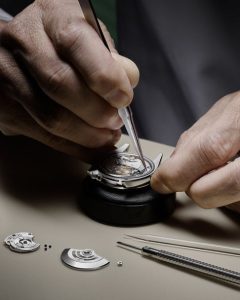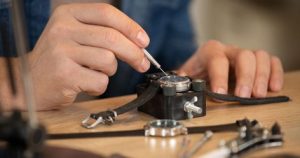Uncategorized
How to Start a Watch Repair Hobby at Home
Watch repair is a rewarding and intricate hobby that allows you to dive deep into the inner workings of timepieces, offering a sense of satisfaction when you bring a broken or malfunctioning watch back to life. Whether you’re interested in fixing old family heirlooms, restoring vintage timepieces, or simply learning more about horology, starting a watch repair hobby at home can be both fun and fulfilling. With the right tools, patience, and a little bit of practice, anyone can begin their journey into watch repair.
Here’s a step-by-step guide on how to start your watch repair hobby at home:
1. Learn the Basics of Watchmaking and Repair
Before diving into repairing watches, it’s essential to understand the basics of watchmaking and the different types of watches you’ll be working on. There are two main types of watches: mechanical watches and quartz watches, and each has its own unique set of repair techniques.
- Mechanical Watches: These watches rely on a spring-driven mechanism to power the watch, and they often require more detailed repair work. They typically have more moving parts, including gears, springs, and a balance wheel.
- Quartz Watches: These watches use a battery-powered movement and are generally simpler to repair, with fewer components. Most quartz watch repairs involve changing the battery, replacing gaskets, or fixing the movement.
You can start learning by reading books, watching tutorials, or taking online courses. Understanding watch parts, movement types, and basic repair terminology will set a solid foundation for your work.
2. Gather the Essential Tools

To repair watches at home, you’ll need a few basic tools to get started. These tools are designed specifically for working with small and delicate watch components. Below is a list of the most essential tools for watch repair:
Basic Watch Repair Tools:
- Screwdrivers: Precision screwdrivers with a variety of small tips (flathead and Phillips) are essential for opening cases and removing screws from the movement.
- Case Opener: A case opener tool helps you safely remove the back cover of the watch without damaging it. There are various types, such as press-type and knife-type openers, depending on the case design.
- Spring Bar Tool: This tool is used to remove and replace spring bars, which attach the watch strap or bracelet to the case.
- Tweezers: Fine-tipped tweezers are used to handle small parts like gears, screws, and crystals. Stainless steel tweezers are best as they won’t rust and can handle the precision needed for watch repair.
- Watch Holder or Cushion: This keeps your watch secure and prevents damage while you work on it.
- Loupe or Magnifying Glass: A magnifying tool is essential for closely inspecting small parts and components.
- Watchmaker’s Hammer: This is a soft-faced hammer that is used to tap delicate parts into place without damaging them.
- Movement Holder: A movement holder is used to securely hold a watch movement while you perform repairs or adjustments.
Optional Tools (as you progress):
- Hand Remover: A tool that helps remove hands (hour, minute, second hands) without damaging the dial.
- Demagnetizer: A tool used to remove any magnetic interference that could affect the movement’s accuracy.
- Crystal Press: This is used to install or replace watch crystals.
- Movement Demagnetizer: Used for quartz watches to demagnetize the movement.
- Lubricants: Special oils designed for watch movements to ensure the parts run smoothly and without excessive wear.
You can purchase these tools individually, or you can find watch repair toolkits that include all the essentials for beginners.
3. Start with Simple Repairs
As with any hobby, it’s best to start with simple repairs and gradually build your skills. Here are a few basic repairs that are easy to learn and practice:
Changing the Battery:
This is one of the most common and straightforward repairs for quartz watches. A dead battery is often the reason a quartz watch stops working, and replacing it is an easy entry point into the world of watch repair.
- Use a case opener to remove the back of the watch.
- Identify the battery, which is typically a small, round coin cell.
- Remove the old battery carefully using tweezers, and insert a new battery in the same orientation.
- Close the case back securely.
Replacing the Strap or Bracelet:
Another easy repair is replacing or swapping out a watch strap or bracelet. This doesn’t require much technical skill but will give you practice with spring bars and your tools.
- Use a spring bar tool to remove the old strap or bracelet.
- Install the new strap or bracelet by positioning the spring bars and securing them into place.
Cleaning the Watch:
If you notice dust, dirt, or moisture inside the case, a simple cleaning might be all that’s needed to improve the watch’s function. Be careful when handling delicate parts, and always use a soft cloth or air blower to clean the exterior.
4. Practice on Inexpensive Watches
As a beginner, it’s important to practice on inexpensive, non-valuable watches before attempting repairs on high-end or family heirlooms. Start by purchasing inexpensive quartz watches or older mechanical watches from thrift stores or online marketplaces. These watches are great learning tools and can give you the opportunity to experiment without the pressure of working on an expensive timepiece.
5. Understand How to Work with Watch Movements
Working with watch movements, particularly mechanical ones, is the next level of watch repair. Mechanical movements contain tiny, intricate parts that must be handled with care. Here are a few things to keep in mind:
- Learn to Disassemble and Reassemble: One of the most important skills for a watch repair hobbyist is learning how to disassemble a movement and put it back together. Be sure to keep track of all the parts as you remove them, and take notes if necessary.
- Lubrication: Some parts of the movement require lubrication to keep them running smoothly. Watch lubricants are specifically designed for different types of movements, and knowing where to apply them is an essential skill.
- Balance Wheel and Escapement: The balance wheel is the heart of a mechanical watch, regulating time. If a watch is running too fast or too slow, the balance wheel may need adjustment. This is a more advanced skill that requires experience and patience.
6. Use Online Resources and Communities
There are many online forums, YouTube channels, and websites dedicated to watch repair. Some great resources include:
- Watch Repair Channel: A popular YouTube channel offering tutorials on watch repair techniques.
- Watchuseek Forum: A community of watch enthusiasts and repair hobbyists where you can ask questions, share experiences, and get tips from seasoned professionals.
- TimeZone Watch Repair Forum: A place to find information on more advanced watch repair techniques, including movement servicing and intricate repairs.
7. Keep Practicing and Be Patient

Watch repair can be a slow and meticulous process, so patience is key. Don’t be discouraged if your first few repairs don’t go perfectly—watchmaking is an art, and mastering the craft takes time and practice. As you gain experience, you’ll learn to troubleshoot issues, handle delicate components, and develop your skills.
8. Upgrade Tools and Expand Skills
As your skills improve, consider upgrading your toolset and expanding your knowledge. You can start experimenting with more advanced repairs, such as regulating the movement for better accuracy, restoring old vintage watches, and even learning how to polish or refinish watch cases. Watch repair is a constantly evolving hobby that offers new challenges and techniques to explore.
Conclusion
Starting a watch repair hobby at home is a highly rewarding endeavor that allows you to learn the intricate art of horology while honing your technical skills. By gathering the right tools, starting with simple repairs, and practicing on affordable watches, you can gradually build up your knowledge and confidence. Whether you’re working on quartz watches or mechanical timepieces, the satisfaction of breathing new life into a broken watch is immense. With patience, dedication, and the right resources, you’ll be able to master the craft of watch repair and create a collection of perfectly functioning timepieces.

